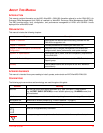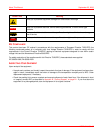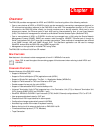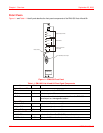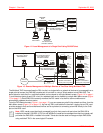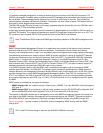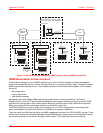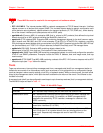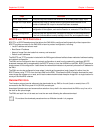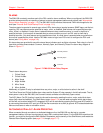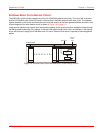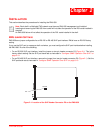
Chapter 1: Overview September 25, 2006
1-6 LTPE-UM-3159-02
In a remotely managed configuration, an external modem must be connected to the EMU-830 front panel V.24
(RS-232) console port. If enabled, alarm conditions cause ASCII messages to be transmitted autonomously over the
dial-up network. These messages can be displayed on a monitor or sent directly to a printer. This provides the
network operator immediate notification of problems. The operator can then initiate a remote TAO session with the
local shelf to further diagnose and correct the problem.
The EMU-830 and the DSL card firmware can be easily upgraded using the Upload utility from the TAO Main menu.
This utility uses TFTP and Xmodem protocols.
A proprietary software download protocol permits firmware to be downloaded to any unit (EMU or DSL line card) in a
multishelf TAO network. This protocol is supported by a special ADC application program that can run on a PC. The
PC connects to the front panel RS-232 V.24 console port of one of the EMUs in the network.
SNMP
SNMP (Simple Network Management Protocol) is an application layer protocol of the Internet suite of protocols,
commonly referred to as TCP/IP (after the two core protocols⎯Transmission Control Protocol and Internet
Protocol), and is designed to be an "open" (non-proprietary) network management technology capable of managing
internetworking equipment from multiple vendors. SNMP is formally specified in a series of related RFC (Request
For Comment) documents from the Internet Engineering Task Force (IETF). The WorldDSL EMU-830 implements
SNMP version 1. Communications standards supported in Version 1 of the SNMP standard include IP, User
Datagram Protocol (UDP), Internet Control Message Protocol (ICMP), and Address Resolution Protocol (ARP). Two
other protocols, Boot Protocol (BOOTP) and Trivial File Transfer Protocol (TFTP), are also included to support IP
address management and download of EMU-830 code over the network.
In an SNMP managed network, each WorldDSL shelf is considered a managed node and contains an SNMP
software agent that resides in the EMU-830. The software agent provides the operating kernel, SNMP protocols,
transport protocols, and management information. Multiple shelves, each of which deploy up to 16 DSL links, can be
centrally managed from a single SNMP-based Network Management Station. Each DSL link consists of an LTU/
STU-C unit installed in the shelf, a remote NTU/STU-R unit, and possibly one or two mid-span doublers. Doublers
are currently supported only with HDSL (e.g., LTU-804, UTU-804) line cards. A link is managed as one DSL system
by SNMP.
SNMP access is provided over two types of interfaces:
• SNMP through LAN. An interface using an Ethernet port (10BASE-T) on the WorldDSL shelf that supports
UDP over IP.
• SNMP through SLIP. An out-of-band (or dial-up) serial interface using the RS-232/RS-485 configurable SLIP
port on the WorldDSL shelf, which supports IP over a SLIP at a maximum 19.2k baud rate.
The network of WorldDSL shelves can be managed by one or more SNMP management stations at the same time
over either of the SNMP interfaces. Management can be performed through the 10BASE-T Ethernet port and the
RS-232/RS-485 SLIP port simultaneously. StarGazer manages WorldDSL shelves using SNMP through LAN.
Figure 1-6 on page 1-7 shows a network of WorldDSL shelves managed by SNMP through LAN and SNMP
through SLIP.
Note: The Multishelf TAO firmware and SNMP agent are factory loaded on all EMU-830 management units.
STU-C and STU-R terminology is used with the G.SHDSL WD92xGx line cards.




